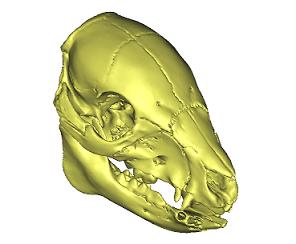Currently, there is no reliable biomechanical model for pediatric skull fractures. The OBL has begun researching the material and mechanical properties of the developing porcine skull during impacts in order to better understand the nature of injury on developing cranial bone in humans.
The project, titled "A Forensic Pathology Tool to Predict Pediatric Skull Fracture Patterns," involves the OBL, MSU Forensic Anthropologist Dr. Todd Fenton. The collaborative effort from multiple departments hopes to generate a computational model for pediatric head injury that will be used by Forensic Pathologists in cases involving abuse.

Dr. Todd Fenton, Ph.D.
Michigan State University
The OBL's preliminary studies investigated the material properties of the developing porcine skull. Through experimentation on thin beam specimens, our researchers hope to examine such properties as failure strength, energy absorbed and elastic modulus of developing cranial bone.


Top: Diagram of beam specimens used to calculate material properties.
Bottom: Computational model of beam specimen during bending.
The research at the OBL will also include impact testing on cranial specimens. CT Scans will be done at Wayne State University after impact testing in order to gain a detailed view of fractures on the cranial surface. The mechanics of the skull fracture propagation will then be examined in order to generate the final computational model.

Computer generated model of porcine skull.

CT Scan of porcine specimen after impact.